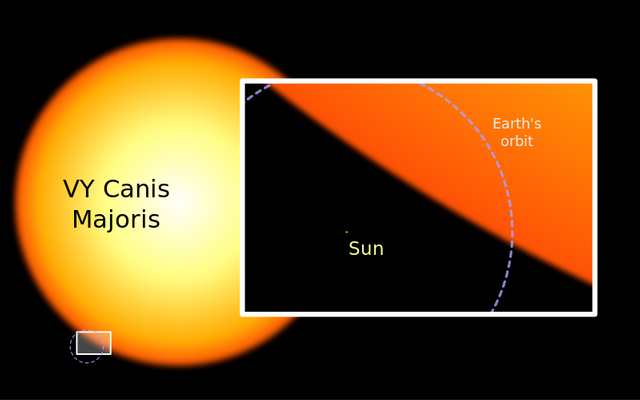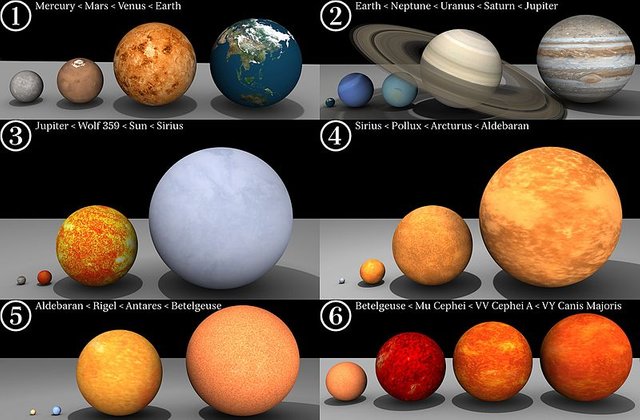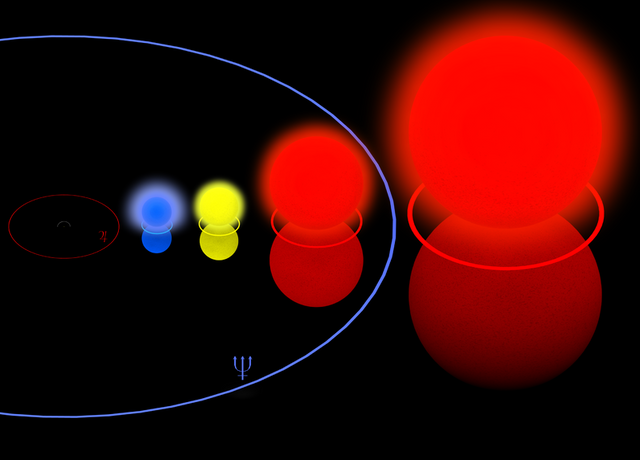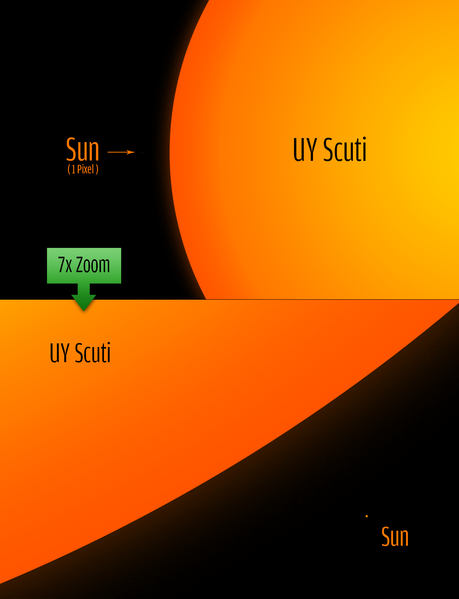Supermassive Stars That Will Make our Sun look like a Grain of Salt
In one of my previous posts, we discussed the Sun, and the important role it plays in our Solar System. We looked at how the gravity from the Sun helps to keep all the planets in orbit, even though the planets also play an important role in keeping themselves in line, by exerting their own sideways motion, this prevents them from getting drawn into the Sun and getting roasted in the process. It's no secret, the Sun is one of the major reasons we are alive, without the Sun, life will be close to impossible here on earth. We will freeze to death, or probably starve because plants won’t be able to carry out photosynthesis, and as we know it, they are the primary producers, that help convert the energy from the Sun into food for both man and animal, hence servicing the food chain.
The major reason the Sun has the power it possesses is because of its size, mass, and its temperature, the Sun accounts for 99.8% of the mass of the solar system. And as we may know, smaller objects orbit larger ones in space, so this means every other object in the solar system orbits the Sun by default. I also explored this in my previous post, so the power of the Sun is partly because of its mass and size. It will interest you to know that there are other Suns out there that will make our starboy look like nothing, and I mean every bit of that. Stars so big, that you will probably run out of zeros trying to quantify the distance across its surface. And in this post, we will look at the 3 of the largest stars out there that are bigger than our Sun by at least 1000 times.
Let’s jump right into it
Betelgeuse
This is one of my favourite stars in the universe, not because of its size or mass or anything out of the ordinary, I love and kind of sympathize with Betelgeuse for certain reasons. You see, as I discussed in my previous post about the importance of the Sun to our Solar System, and to life on planet Earth, I did mention why the Sun is able to produce all the energy it produces, which is through a process known as nuclear fusion reaction. This reaction entails the burning of hydrogen which is then converted to helium, this process is what’s responsible for all the energy the Sun emits, and when the Sun runs out of hydrogen to burn, a series of events sets in, that leads to the eventual death of the Sun. Now, Betelgeuse is a star known as a “red supergiant” that is at the end of its life cycle, and its death is imminent which is said to be in a supernova explosion (talk about leaving with a bang!).
This massive star, is about 1.4 billion kilometres wide, and is a thousand times wider than our Sun and has a mass that is between 15 - 25 times heavier than our star. Betelgeuse is so massive to the point that, if you place Betelgeuse in the position that our Sun currently occupies, it will stretch all the way past the orbits of Mar, and head into the asteroid belts… how massive is that? Now, the reason I love Betelgeuse if because, for a star that massive, you’d expect it to be rotating at a very slow pace due to its enormous size, and mass, but you’ll be damn wrong to think so. Betelgeuse rotates at a lightning speed of 53,900 Km/h (33, 500 mph) which reminds me of one of the deadliest fighters in Game of Thrones - The Mountain; Big, strong and super fast!
We cannot account for the rotation of Betelgeuse
A statement issued by Craig Wheeler, who is an astronomer at the University of Texas at Austin; he added
“It’s spinning 150 times faster than any plausible single star just rotating and doing its thing.
The answer was unveiled by Mr Wheeler and his team who later discovered with the help of computer models that explains the freaky behaviour of the star. It appears that 100,000 years ago, Betelgeuse engulfed a star that is almost the same mass as itself. This makes Betelgeuse now to possess the angular momentum of the devoured star’s orbit, hence, this speeds Betelgeuse’s rotation rate. Even stars and planetary bodies can be cannibals too, it's a star eat star universe, you either eat, or get eaten.
As mentioned earlier, the star is almost at the close of its lifetime, this conclusion was reached when evidence suggests that the star was producing heavier materials in its core, materials that will be crucial in the creation of other planetary bodies like planets, satellites or a new star, when the massive giant star eventually dies in a supernova. Betelgeuse is the known as the 9th brightest star, and the 2nd brightest in the constellation of Orion, known to possess a distinct red colour.
VY Canis Majoris
Meet the dying star, not until a few years ago, VY Canis Majoris was actually the largest star known to exist in the universe, before it lost its place to UY Scuti and fell into the category of “one of the largest” stars know. Just like Betelgeuse, this monster is also at the close of its lifetime, and a series of interesting events will soon follow, one that will lead to the birth of something so powerful, it is believed to be second only to the Big Bang. VY Canis Majoris is a supergiant that can be found in the constellation Canis Major, despite it being one of the largest stars in the night sky, it is also one of the stars with the most mass, as well one of the brightest (luminous).
This star is really large, if placed in our solar system, its surface will extend to Jupiter, others believe the radius of this bad boy will encroach the orbits of Saturn. VY Canis Majoris is an impressive star, but one of the main things I find really exciting about this star is its impending death. You see, VY CM is a dying star, as we may know, stars are literally massive fusion reactors that pump energy into space, and similarly the stars intense gravity takes a toll on its internal core. So, for a period of time, there is this never-ending war going on between fusion and gravity. The sad thing is, these stars don’t have an unlimited supply of fuel that powers this nuclear fusion reaction, so they eventually run out of fuel energy - gravity wins. And when gravity wins, that’s the birth of bad news.
In less than a second, the core of this star will shrink to its original size, prompting the birth of a black hole, this initiate a cannibalized activity as the black hole starts eating what was formerly VY Canis Majoris, this keeps on happening, an enormous amount of both frictional and magnetic forces are being released. The baby black hole keeps eating the body of the star
At such a fast rate it chokes, and an enormous beam blast of energy is released, and in less than a second, it explodes over a hundred times more energy that will take our Sun it’s entire lifetime to produce. What is now left is a newborn black hole, and a duo jet of energy racing through the universe at the speed of light. These jets are known as gamma-ray bursts, known to be highly energetic, and possess such extensive raw energy, second only to the Big Bang.
Gamma-ray burst only last for a few seconds, but they are known to have the capacity to roast anything in its path. If a gamma-ray burst should occur in the Milky Way galaxy, close to our Solar System, it has the power to vaporise the entire planets found in the Solar System.
Luckily for us, most gamma-ray bursts occur outside our Milky Way galaxy
UY Scuti
As far as the currently observable universe is concerned, well, at least to the extent that we have successfully explored, UY Scuti is the largest star that currently occupies that position at the moment. Known as the largest star by radius, this bright red supergiant is located in the Constellation Scutum, which is 9.500 light years away. This monstrous star is really large, possessing a radius that is 1,700 times bigger than that of our Sun. The star is not just big on size, but it’s heavy as well, and it beats our Sun in the weight category too, by possessing a weight 30 times heavier than the star of our Solar System.
Jillian Scudder, an Astrophysicist of the University of Sussex had this to say about VY Scuti
Mass and physical size don’t always correlate for stars, particularly for giant stars.
With a radius of 1,700 times larger than that of the Sun, this will put this star at 8 astronomical unit across, which is the equivalent of 8 times the distance between the Sun and our little home planet - the earth. This means that the photosphere of VY Scuti is so massive, it can extend beyond the orbits of Jupiter.
This star is one of a class of stars that varies in brightness because it varies in size, so this number is also likely to change over time. The margin of error on this measurement is about 192 solar radii. This uncertainty is why I used ‘possibly one of the largest stars’ in my description of UY Scuti. If it is smaller by 192 solar radii, there are a few other candidates that would beat UY Scuti.
The largest stars in the observable Universe are often the coolest, as we mentioned earlier, VY Canis Majoris that was formerly the largest star known, is only 3,500 Kelvin compared to our Sun’s 5,778 Kelvin despite being estimated to be 1,500 times smaller. Now, UY Scuti has a temperature of 3,365 Kelvin, which is even less than that of VY Canis Majoris. This goes on to prove that the larger the star, the cooler it is. However, recent observation shows that UY Scuti has started fusing helium and hydrogen in shells within its core; and given the location of this star to be around the disk of the Milky Way, is a suggestion that it is rich in metal.
Now, after the fusion of heavy metals elements at its core, it will initiate the production of iron, which will disrupt the balance of both radiation and gravity within its core, hence, resulting in a core-collapse supernova. It is generally anticipated that stars like UY Scuti will evolve back to hotter temperatures and eventually become luminous blue, yellow hypergiants or Wolf-Rayet star hereby producing stronger stellar wind.
video animation
Video uploaded by David Raymond Bass
This video animation shows the various sizes of solar objects out there in space, it started with the planets in our little Solar System, and moved all the way up to the big boys, before finally getting to the largest star in the universe, the red supergiant known as UY Scuti.
References
Universe Today - Biggest Star in the Universe





I still don't understand the concept of black holes, like it swallows things up but where do these things go, do they just stop existing?
Well, I am not certain anyone or anything has gone to the other side of a black hole and made it back, the closest we've come to the other side of a black hole is in sci-fi fiction novels and more notably, in the movie 'Interstellar'. Nobody really knows what happens beyond the boundary of the black hole called the event horizon (It is where gravity is just strong enough to drag light back, and prevent it from escaping. Because nothing can travel faster than light, everything else will get dragged back also)
You can check out this post by Stephen Hawking alas, where he wrote extensively about black holes.
You can as well watch a sci-fi movie Event Horizon 1997
Congratulations! Your post has been selected as a daily Steemit truffle! It is listed on rank 12 of all contributions awarded today. You can find the TOP DAILY TRUFFLE PICKS HERE.
I upvoted your contribution because to my mind your post is at least 30 SBD worth and should receive 223 votes. It's now up to the lovely Steemit community to make this come true.
I am
TrufflePig, an Artificial Intelligence Bot that helps minnows and content curators using Machine Learning. If you are curious how I select content, you can find an explanation here!Have a nice day and sincerely yours,

TrufflePigThis post has been voted on by the steemstem curation team and voting trail.
There is more to SteemSTEM than just writing posts, check here for some more tips on being a community member. You can also join our discord here to get to know the rest of the community!
Hi @agbona!
Your post was upvoted by utopian.io in cooperation with steemstem - supporting knowledge, innovation and technological advancement on the Steem Blockchain.
Contribute to Open Source with utopian.io
Learn how to contribute on our website and join the new open source economy.
Want to chat? Join the Utopian Community on Discord https://discord.gg/h52nFrV